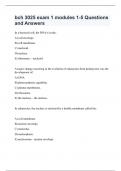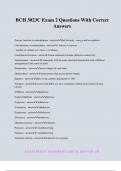Bch 3025 - Study guides, Class notes & Summaries
Looking for the best study guides, study notes and summaries about Bch 3025? On this page you'll find 38 study documents about Bch 3025.
Page 4 out of 38 results
Sort by
Package deal for NUR 325 Exam questions and answers 2024
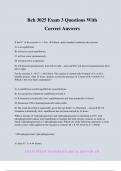
-
Bch 3025 Exam 3 Questions With Correct Answers
- Exam (elaborations) • 61 pages • 2024
-
- $13.49
- + learn more
Bch 3025 Exam 3 Questions With Correct Answers If the G'° of the reaction A -> B is -40 kJ/mol, under standard conditions the reaction: A) is at equilibrium. B) will never reach equilibrium. C) will not occur spontaneously. D) will proceed at a rapid rate. E) will proceed spontaneously from left to right. - answerE) will proceed spontaneously from left to right. For the reaction A - B,G'° = -60 kJ/mol. The reaction is started with 10 mmol of A; no B is initially present. After 2...
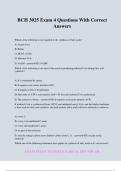
-
BCH 3025 Exam 4 Questions With Correct Answers
- Exam (elaborations) • 78 pages • 2024
- Available in package deal
-
- $13.49
- + learn more
BCH 3025 Exam 4 Questions With Correct Answers Which of the following is not required in the synthesis of fatty acids? A) Acetyl-CoA B) Biotin C) HCO3- (CO2) D) Malonyl-CoA E) NADH - answerE) NADH Which of the following is not true of the reaction producing malonyl-CoA during fatty acid synthesis? A) It is stimulated by citrate. B) It requires acyl carrier protein (ACP). C) It requires CO2 (or bicarbonate). D) One mole of ATP is converted to ADP + Pi for each malonyl-CoA synthesized...
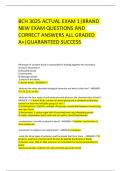
-
BCH 3025 ACTUAL EXAM 1|BRAND NEW EXAM QUESTIONS AND CORRECT ANSWERS ALL GRADED A+|GUARANTEED SUCCESS
- Exam (elaborations) • 26 pages • 2024
-
- $13.49
- + learn more
BCH 3025 ACTUAL EXAM 1|BRAND NEW EXAM QUESTIONS AND CORRECT ANSWERS ALL GRADED A+|GUARANTEED SUCCESS What type of covalent bond is responsible for holding together the secondary structure of proteins? A) Disulfide bonds D) Ionicbonds B) Hydrogen bonds E) None of the above C) Amide bonds - ANSWER- what are the most abundant biological elements and what is their tier? - ANSWER-C, N, O, H, 1st tier what are the four types of unit molecules and what are the characterist...
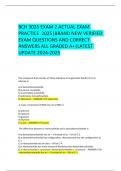
-
BCH 3025 EXAM 2 ACTUAL EXAM PRACTICE 2025|BRAND NEW VERIFIED EXAM QUESTIONS AND CORRECT ANSWERS ALL GRADED A+|LATEST UPDATE 2024-2025
- Exam (elaborations) • 39 pages • 2024
-
- $14.49
- + learn more
BCH 3025 EXAM 2 ACTUAL EXAM PRACTICE 2025|BRAND NEW VERIFIED EXAM QUESTIONS AND CORRECT ANSWERS ALL GRADED A+|LATEST UPDATE The compound that consists of ribose linked by an N-glycosidic bond to N-9 of adenine is: A) a deoxyribonucleoside. B) a purine nucleotide. C) a pyrimidine nucleotide. D) adenosine monophosphate. E) adenosine. - ANSWER-E) adenosine A major component of RNA but not of DNA is: A) adenine. B) cytosine. C) guanine. D) thymine. E) urac...
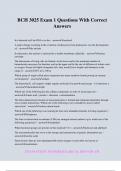
-
BCH 3025 Exam 1 Questions With Correct Answers
- Exam (elaborations) • 10 pages • 2024
- Available in package deal
-
- $12.49
- + learn more
BCH 3025 Exam 1 Questions With Correct Answers In a bacterial cell, the DNA is in the: - answernucleoid A major change occurring in the evolution of eukaryotes from prokaryotes was the development of: - answerthe nucleus In eukaryotes, the nucleus is enclosed by a double membrane called the: - answernuclear envelope The dimensions of living cells are limited, on the lower end by the minimum number of biomolecules necessary for function, and on the upper end by the rate of diffusion of so...
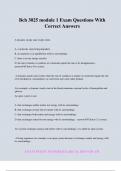
-
Bch 3025 module 1 Exam Questions With Correct Answers
- Exam (elaborations) • 7 pages • 2024
- Available in package deal
-
- $12.49
- + learn more
Bch 3025 module 1 Exam Questions With Correct Answers A dynamic steady state results when A. a molecule stops being degraded. B. an organism is at equilibrium with its surroundings. C. there is no net energy transfer. D. the rate of intake or synthesis of a molecule equals the rate of its disappearance - answerChoice D is correct. A dynamic steady state results when the rate of synthesis or intake of a molecule equals the rate of its breakdown, consumption, or conversion into some other...
Bch 3025 Exam Package Deal.

How much did you already spend on Stuvia? Imagine there are plenty more of you out there paying for study notes, but this time YOU are the seller. Ka-ching! Discover all about earning on Stuvia

